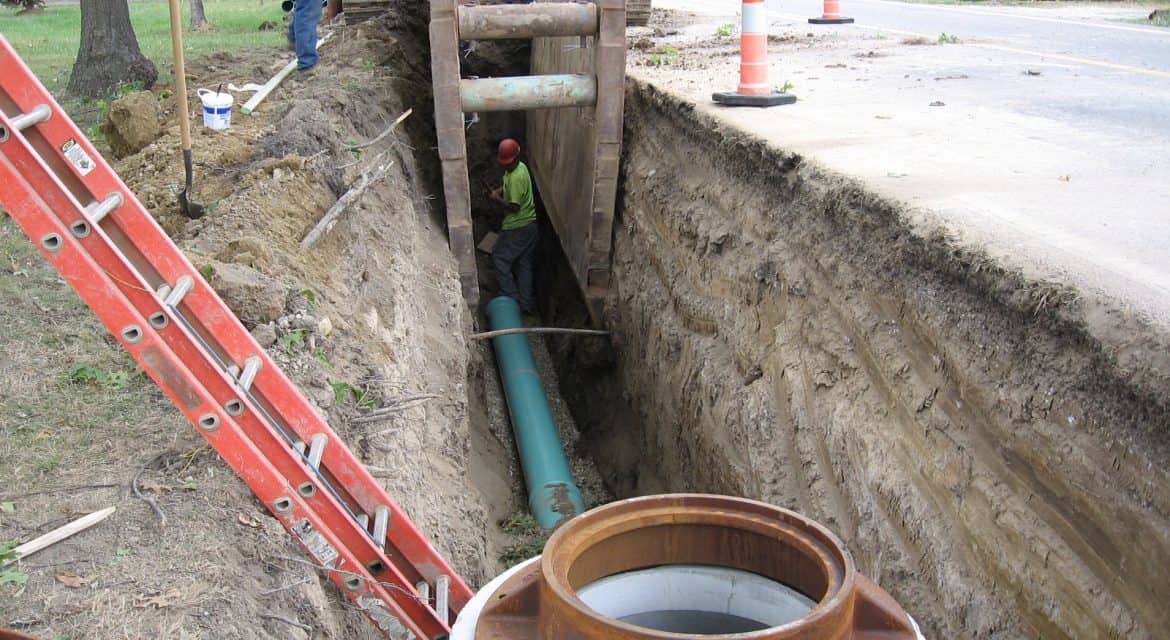
BATAVIA, Ohio (Aug. 17, 2017) – A public hearing will be held at 7 p.m. Monday, Sept. 25, to allow the Board of County Commissioners to receive input from Newtonsville property owner on the construction of a wastewater system and treatment plant. The public hearing will be held at the Pattison Park Lodge, 2228 US 50, Batavia 45103.
Currently, properties in the Village of Newtonsville have septic systems. The project will serve 145 property owners and 230 parcels of land in and around the village. In October 2012, residents were notified by Clermont Public Health that a significant number of homes had failing septic systems, and sewage created a health risk. At that time, Public Health said that a centralized sewer system and wastewater treatment plant were needed.
Since then, the Clermont County Water Resources Department (WRD) has completed extensive engineering fieldwork and project design. A number of public information meetings have been held, and letters have been sent to property owners to notify them of progress. The design of the system and wastewater plant, which is proposed to be built on vacant land behind the village administration building, has been completed. The treatment plant is designed to treat up to 57,000 gallons a day.
The total cost of the Newtonsville Collection System Assessment Project and the Newtonsville Wastewater Treatment Plant Project is estimated to be nearly $8.2 million. Grants will defray the cost. The project has been awarded a $2 million grant from USDA Rural Development, and a $1 million grant from the Ohio Public Works Commission. The county will kick in $1.1 million from wastewater capital improvement funds. Property owners will be assessed for the balance, with a 40-year loan at an interest rate of 2.25%. The estimated assessment is $189.93 per frontage foot of property over the 40 years, said WRD Director Lyle Bloom.
If commissioners approve the project, construction is expected to start in September 2018 and to be completed in December 2019, Bloom said.
Certified letters will be sent to all property owners notifying them of the public hearing.
More information on the project can be found on the project’s website.
#########

BATAVIA, Ohio (March 9, 2017) – Interested in learning more about county government and how your tax dollars are spent? Clermont County is celebrating National County Government Month – April – by holding open houses on consecutive Tuesdays in April. The public is invited and is asked to register at www.clermontcountyohio.gov/national-county-government-month or call Kathleen Williams at 513.732.7597.
Tuesday, April 4: Meet Your Commissioners
10-11 a.m.: 101 E. Main St., Batavia, Third Floor
Meet the Commissioners in Session Room. Learn about the basics of county government, the BCC’s responsibilities, what’s on tap for 2017. Q&A.
Tuesday, April 11: #GreenClermont – Protecting our water & environment
10 a.m.-noon Bob McEwen Water Treatment Plant, 3960 Greenbriar Road, Batavia
Take a tour of the plant and learn from our Water Resources team how water is treated in Clermont County. Q&A. Also participating: Office of Environmental Quality and Soil & Water Conservation District.
Tuesday, April 18: Law, Order and Justice
11 a.m.-noon: Sheriff’s Office , 4470 SR 222, Batavia
Meet Sheriff Leahy and his chiefs. What is the Sheriff’s Office responsible for? What are its biggest challenges? Q&A.
Concurrent:
1-2 p.m.: Municipal Court, 4430 SR 222, Batavia: Representatives from Municipal Court, the Prosecutor’s Office and Public Defender’s Office talk about their roles and how the court functions. Q&A.
1-2 p.m.: Common Pleas Court, 270 E. Main St., Batavia: Representatives from Common Pleas Court, the Prosecutor’s Office and Public Defender’s Office talk about their roles and how the court functions. Q&A.
Tuesday, April 25: Supporting Families & Healthy Living
10 a.m.-11 a.m.: Representatives from Children’s Protective Services, Child Support Enforcement, and Developmental Disabilities on how their agencies make a difference. Q&A.
11 a.m.-noon: Representatives from Clermont Public Health and Mental Health & Recovery Board talk about their initiatives and challenges. Q&A.
Both sessions at Engineer’s Training Room, 2381 Clermont Center Drive, Batavia.
#########
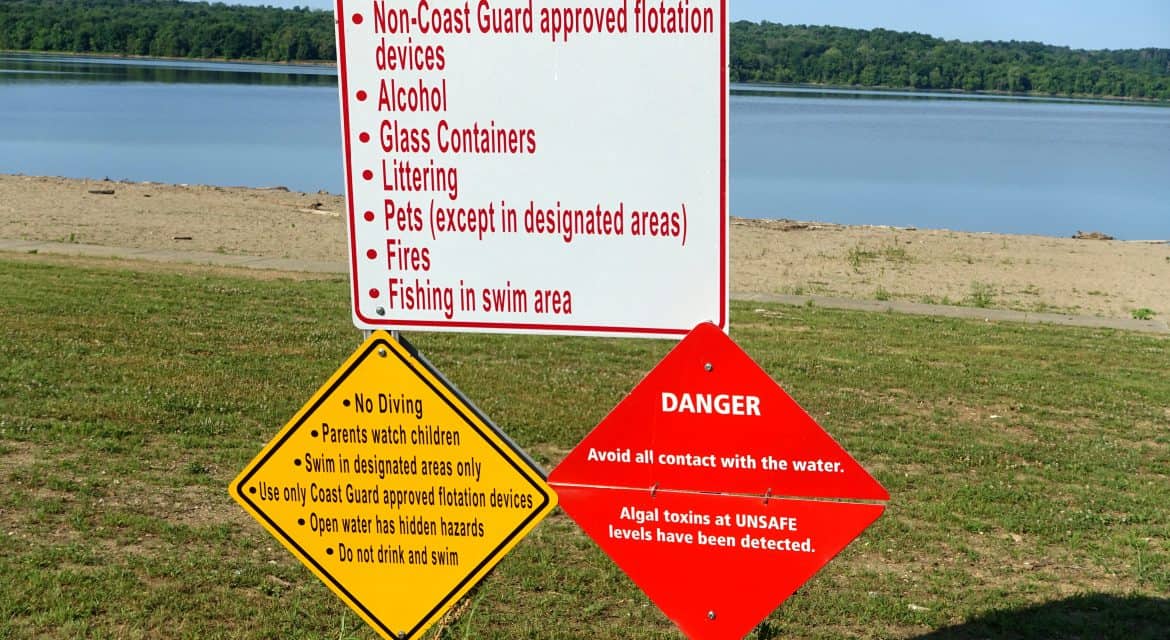
BATAVIA, Ohio (June 14, 2016) The camping beach at East Fork State Park is currently under a Danger Advisory due to unsafe levels of algal blooms. More information can be found at the BeachGuard website.
The Ohio Department of Natural Resources updates the BeachGuard site on a regular basis as test data is delivered.
The Danger Advisory indicates that microcystin levels meet or exceed 20 parts per billion. When the Danger sign is posted, people should avoid all contact with the water.
Related: County to test for HABs weekly
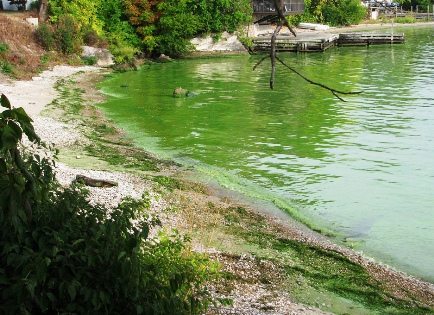
BATAVIA, Ohio (June 14, 2016) – The State of Ohio is now requiring that public water systems that use surface water as a source must test the water on a regular basis for cyanobacteria — harmful algal blooms. The state is coordinating action among the Ohio Environmental Protection Agency, Department of Health, and Department of Natural Resources as it bolsters its response to HABs.
In response, the county Water Resources Department is increasing the frequency of its sampling and testing for cyanobacteria at Harsha Lake to weekly, which began June 1. “Weekly samples will be collected and tested and we will test more frequently if any blooms are detected,” said Director Lyle Bloom.
Previously, the reporting was voluntary; now it is mandatory. The county’s reports will go to the Ohio EPA.
Harmful algal blooms, which often look like blue-green scum atop the water surface, are caused by warm temperatures and an overload of nutrients in bodies of water. They produce a toxin called microcystin, which, even in minuscule amounts, can be harmful to people and animals. Last year, the Ohio River near Cincinnati had an outbreak of HABs. In Clermont County, HABs on Harsha Lake in June 2014 led to public health advisories warning against swimming in the lake. Toledo had to shut down its water intake system after a serious outbreak of HABs on Lake Erie in 2014.
Harsha Lake provides about 25 percent of the drinking water for residents of Clermont County. That water is treated at the Bob McEwen Water Treatment Plant. “We have multiple barriers at treatment to effectively prevent or remove algal toxins,” said Bloom. These include:
“We have been very rigorous in our monitoring of HABs,” said Bloom. “We are well prepared for the state’s new requirements.”
As well, the Ohio Departments of Health and Natural Resources are doing more outreach on HABs:
One-stop website for beach safety: Ohio’s BeachGuard website (http://publicapps.odh.ohio.gov/BeachGuardPublic/Default.aspx) will now be the single resource for advising the public about recreational water quality.
More signs: At state parks, including East Fork and Stonelick, white signs, describing what algal blooms look like, are posted at the beach and boat ramps. An orange warning sign will be added when toxins reach a certain threshold, and a red sign if they reach the danger level.
Advisories: Recreational public health advisories will be issued when an algal bloom is confirmed and/or toxin levels meet a particular threshold (for microcystin, 6 parts per billion). An elevated public health advisory will be issued when microcystin levels meet 20 parts per billion.
According the Department of Health, health effects of algal bloom exposure can range from a rash, hives, blisters, severe diarrhea, vomiting, and abdominal pain to numbness, dizziness, abnormal liver function, difficulty breathing and death. These symptoms can occur more quickly and severely in dogs and other animals.
########
For more information:
Lyle Bloom, Clermont County Water Resources Department
lbloom@clermontcountyohio.gov; 513-732-8860
Julianne Nesbit, Clermont County Public Health
jnesbit@clermontcountyohio.gov; 513-732-7935
Ohio Department of Natural Resources
Media contact: Bethany McCorkle
Bethany.McCorkle@dnr.state.oh.us; 614-265-6860
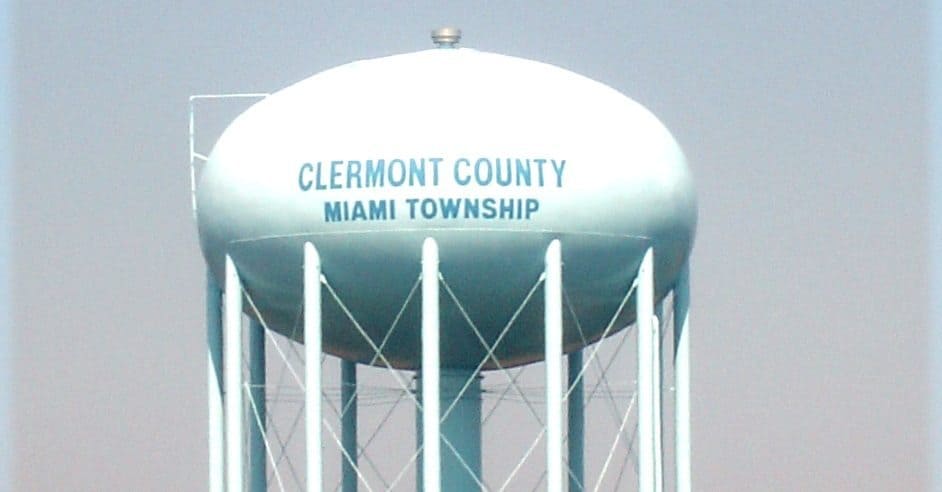
BATAVIA, Ohio (May 4, 2016) – The Clermont County Water Resources Department (WRD) plans to construct more than $9 million in capital projects for 2016.
On May 4, Clermont County Commissioners approved a five-year capital plan for the department.
The 2016 projects include:
• Replacement of 9,440 feet of water main in Goshen Township; $2.1 million
• Installation of 3,200 feet of sewers, manholes and laterals in Miami Township, $1.1 million
• Improvements to booster pump stations in Miami Township, $420,250
• Replacing 3,900 feet of water main in Miami Township, $558,600
• Replacing 7,270 feet of sanitary sewers in Tate Township, $1.7 million
• Improvements in lift stations in Union and Pierce Townships, $817,440
• Rehabilitating 21,247 feet of sewer main and other rehab work in Union and Batavia Townships, $2.9 million.
The Water Resources Department is also working with the Clermont County Engineer, Transportation Improvement District, and Ohio Department of Transportation on various projects, including the widening of Old SR 74; Branch Hill Guinea Road reconstruction; Aicholtz Road connector; and Wolfpen-Pleasant Hill roadwork. Replacement of water and sewer mains on those projects will total $2 million.
“These projects are fully funded,” said WRD Director Lyle Bloom. “It’s important that we continue to invest in our water and wastewater infrastructure on a planned basis. In some cases, we are replacing water mains that were installed in the 1950s.”
Capital projects are funded through a combination of user fees and grants. The Water Resources Department has approximately $23 million in improvements planned for waterworks projects and $38 million planned in wastewater improvements for 2016-2020.
########
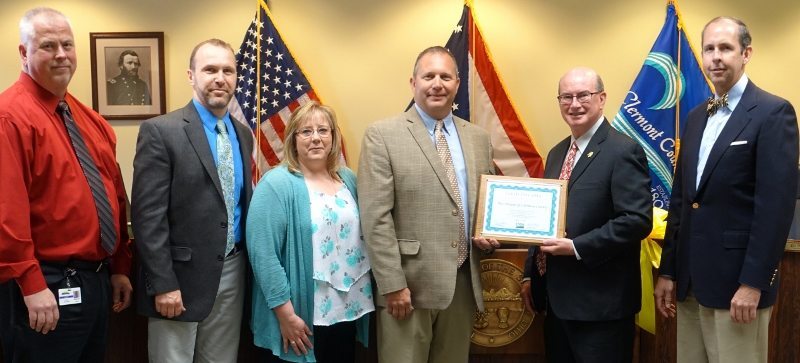
WASHINGTON, D.C. (April 20, 2016) – This week, representatives from USDA’s Rural Development team will be celebrating Earth Day by visiting newly funded projects that will improve rural water quality and safety in 33 states across the country. USDA is investing $183 million in 60 water and wastewater infrastructure projects through Rural Development’s Water and Environmental Program (WEP), which provides technical assistance and financing to develop drinking water and waste disposal systems for communities with fewer than 10,000 residents.
“Safe drinking water and sanitary waste disposal systems are vital not only to public health, but also to the economic vitality of small communities,” said Agriculture Secretary Tom Vilsack. “Helping rural communities build and upgrade their water infrastructure is one more way USDA strengthens rural areas. Building and maintaining water infrastructure creates jobs, boosts the economy, and provides rural families with safe, reliable water and wastewater facilities that improve the environment.”
In Ohio, the Village of Newtonsville and the surrounding area will benefit from a loan of $4,218,000 and a grant of $2 million to the Clermont County Commissioners. Funds will be used to construct a new wastewater collection and treatment system for nearly 400 residents. Newtonsville is situated along the East Fork Little Miami River basin – which flows into the Little Miami River – a state and national scenic river. Roughly 40 percent of 171 systems on line in the area are either in failure or at risk of failure. The new wastewater treatment facility will help protect the Little Miami River watershed – which flows through all or part of 11 Ohio counties – safeguarding the health of area residents and helping to protect the environment.
Seventeen of the Earth Day recipients announced today are receiving funding priority through a 2014 Farm Bill provision that encourages communities to adopt regional economic development plans. These projects are centered on collaboration and long-term growth strategies. They leverage outside resources and capitalize on a region’s unique strengths.
Funding for each project announced today is contingent upon the recipient meeting the terms of the loan, grant or loan/grant agreement.
For more information, visit www.usda.gov/results.
(Photo: USDA Rural Development announces it has awarded a $4.2 million loan and $2 million grant to Clermont County to help construct a new wastewater treatment system in Newtonsville. From left, Chris Rowland and Lyle Bloom, Water Resources Department; Cindy Cameron and Ashley Kelly, USDA; Commissioner Bob Proud, Commissioner David Uible.)